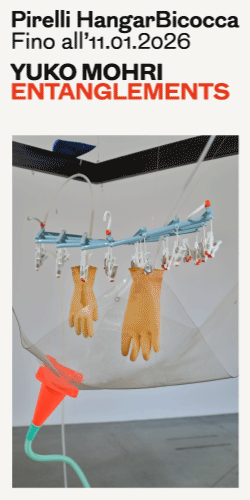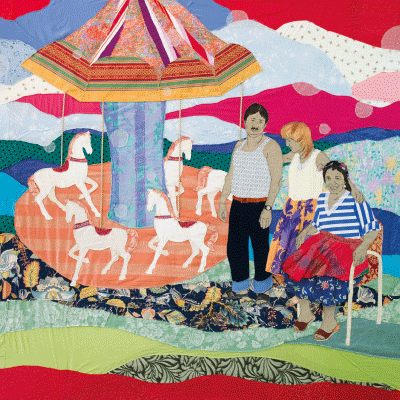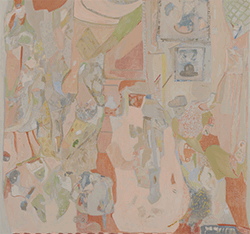[nemus_slider id=”46274″]
Scroll down for the English version
Il 22 giugno scorso la giuria presieduta da Tunga ha assegnato il Prix Canson all’artista argentino Adrián Villar Rojas, nel corso di una serata tenutasi al Palais de Tokyo.
Abbiamo fatto alcune domande a Adrián Villar Rojas riguardo al premio e in vista della sua prossima mostra a Novembre alla Fondazione Sandretto Re Rebaudengo.
ATP: Qual è il punto di partenza per la creazione delle tue opere?
Adrián Villar Rojas: Il contesto è lo strumento principale. È fondamentale per poter conoscere, il più profondamente possibile, il luogo in cui svilupperò un progetto, prima di arrivare con tutto il mio team. Visitare la città, l’istituzione, i siti scelti e fare una ricerca scrupolosa su tutti i problemi principali, precedono sempre lo sviluppo del progetto stesso. Anzi, la tecnica dello “scouting”, per usare un concetto cinematografico, adesso è diventata la prima fase dei miei progetti: quella in cui pianto il primo seme nel luogo e il luogo pianta il primo seme nella mia mente. Dopo quel coinvolgimento iniziale con il posto, l’albero con tutti i suoi rami comincia a crescere e non so mai quanto sarà alto o quanti rami avrà. Pertanto, non si tratta ne di quello che voglio fare nel luogo, ne delle necessità del posto, ma di ciò che il luogo merita. Quindi il progetto è il risultato di una complessa negoziazione con il contesto.
ATP: Quali sono le tue fonti d’ispirazione principali?
AVR: Mi interessa molto lavorare all’interno di film e libri. Leggo molti libri e guardo molti film, contemporaneamente, senza l’intenzione di finirli. Sono come punti dove accamparsi e pensare. Amo vivere all’interno di quelle narrazioni, rimanere lì per un po’ e tornare carico per nuovi processi di pensiero.
ATP: Sei conosciuto soprattutto per le tue opere in argilla, ma utilizzi anche disegni e altri mezzi. Esiste una relazione tra tutti questi elementi?
AVR: Tutti i miei progetti si intrecciano e sono intercomunicanti. Non vi è alcuna differenza tra di loro in termini di discipline.
ATP: Forse ti hanno fatto questa domanda molte volte: perché hai scelto l’argilla come materiale principale per le tue sculture?
AVR: È una lunga storia.
Il mio primo ricordo dell’argilla risale all’infanzia. Mia madre era molto giovane ed energica, perciò mandava me e mio fratello a lezioni di inglese, lezioni d’arte e a fare molti sport diversi. Il mio primo ricordo dell’argilla, quindi, risale a quei giorni, in particolare a quelle lezioni d’arte che avevo iniziato a frequentare quando avevo sei anni. Da allora, la mia infanzia è stata attraversata da argilla e plastilina. Nella maggior parte dei giochi che facevo con i giocattoli, erano coinvolti entrambi i materiali. Io e mio fratello li usavamo per fare armature e macchinari super tecnologici per i nostri personaggi Lego e Playmobil. Non sopportavamo le limitazioni dei temi standardizzati proposti dai disegnatori dell’azienda. Questa modalità di gioco con l’argilla e la plastilina come strumenti per trasformare il design prestabilito, è durata fino a quando avevo undici anni; e non sono più tornato a questi materiali prima del 2007 quando li ho presi sul serio come durante l’infanzia.
In quell’anno, nel 2007, ho fatto un progetto per arteBa, in cui ho usato l’argilla cruda per la prima volta nella mia carriera professionale. È stata anche la prima volta in cui ho riunito un gruppo di collaboratori, che in realtà erano miei amici e compagni della Facoltà di Belle Arti. Mi hanno aiutato gratuitamente, con un grande senso di solidarietà. La casa dei miei genitori a Rosario era diventata un laboratorio: dalla cucina alle camere da letto, ogni singolo angolo della casa era diventato un gruppo di lavoro ventiquattro ore su ventiquattro, con una decina di persone che lavoravano tutto il giorno per quasi due mesi. Poi abbiamo dovuto trasportare l’opera, che effettivamente consisteva in migliaia di piccole opere, da Rosario a Buenos Aires. Pieces of People We Love è un tavolo enorme, dieci metri per otto, letteralmente pieno di migliaia di piccoli oggetti che narrano una storia. È stata una tragedia futuristica che si è conclusa nel suicidio; il tavolo doveva coinvolgere tutti i rapporti di azione e reazione necessari, fin dall’inizio dell’universo, affinché quella tragica storia d’amore si realizzasse. Pertanto, c’è stata una situazione narrativa di azione e reazione tra ogni oggetto e ogni figura collocati sopra – o sotto – il tavolo. L’argilla cruda, però, non era l’unico materiale che abbiamo usato. La logica costruttiva principale che ho usato per la realizzazione di questo progetto è stata il collage, ma in tre dimensioni, nel modo più modesto e artigianale possibile. Inoltre, ho anche messo una narrazione dietro la narrazione. Ho immaginato che questo progetto fosse stato assegnato come compito per una lezione d’arte e veniva svolto da un nerd ossessivo che si è dedicato ad un compito solitario e che alleviasse la sua tristezza. O anche un progetto scientifico al liceo svolto da una o un adolescente triste che ha deciso di raccontare una storia d’amore futuristica usando quello che potrebbe trovare a casa. Dunque, una miriade di materiali e di oggetti ready-made sono stati i protagonisti dell’opera, così come lo è stata l’argilla cruda: c’era un’enorme torta al cioccolato che raffigurava la strana scena di un dinosauro che si trovava tra decine di croci bianche, nel mezzo di una foresta inquietante; uno zaino da adolescente tutto dipinto con immagini delle profondità dell’oceano nell’era giurassica; pianeti, satelliti e stazioni spaziali in polistirolo; un acquario con pesci veri che vi nuotavano all’interno; una vecchia TV che mostrava i video a ripetizione; montagne e pietre fatte di cartone; pettirossi finti che fischiettavano melodie dei Nirvana; un cimitero con centinaia di croci di legno di balsa piantate in colline di terra biologica sotto il tavolo; dei robot giocattolo comprati nella China Town di Buenos Aires e statuette di resina epossidica che raffiguravano i personaggi principali di questa storia d’amore, e l’elenco può andare avanti per ore. Come ho detto, c’erano letteralmente migliaia di pezzi minuziosi in Pieces of the People We Love. Ora che rivisito questo lavoro iniziale mi rendo conto che la resina epossidica è lo stesso materiale che abbiamo usato per fare le miniature di The Work of the Ocean qui in Belgio. In questo mondo, nulla accade per caso.

L’anno seguente, nel 2008, mi sono trasferito da Rosario a Buenos Aires e sono avvenuti due grandi cambiamenti nella mia vita: ho cominciato a vivere da solo e ho preso uno studio per la prima volta. Ho avuto questo ricordo d’infanzia dell’argilla, di quanto fosse facile da maneggiare ed ero da solo a Buenos Aires con uno studio umile ma comodo, solo per me. Avevo anche cinque chili di argilla a casa e un sacco di tempo per lavorare. Così, completamente di punto in bianco, ho iniziato a modellare piccoli pezzi in argilla cruda in qualsiasi forma, da un iPod, un blister di pillole o un paio di scarpe da ginnastica, al busto di Gesù Cristo, d’un Uomo di Cro Magnon o dei miei genitori e dei miei nonni, che sarebbero poi diventati What Fire Brought to Me. Non riuscivo a smettere di modellare cose in argilla; presto ho capito che quasi tutto poteva essere trasformato in una grande o piccola scultura d’argilla. In poche settimane avevo centinaia di pezzi sparsi in tutto lo studio, sugli scaffali, ma anche sul pavimento. Erano cresciuti ovunque, come funghi. Ho anche un modello in scala di mio padre in decomposizione sul pavimento nel suo grembiule da lavoro, con fiori che crescono dal suo ventre e tutto il resto, proprio sotto il mio tavolo da lavoro, come se fosse morto proprio lì da mesi. O il busto di mio nonno peruviano che mi fissava da uno scaffale. O il busto di mio nonno argentino con i suoi occhiali, che guardava come se si stesse addormentando su un altro scaffale. Era di grande effetto. Era come un museo della mia vita, mostruoso e in scarsa risoluzione, tutto grigio e decadente. Modellare con quest’argilla cruda è stato senza dubbio un modo per rintracciare i ricordi, per elaborare la mia solitudine in una grande città lontana da casa e per commemorare quei cari parenti, come mio nonno ebreo-argentino che ci ha lasciati recentemente. Da tutte queste circostanze è emersa una nuova idea. Invece di passare da un materiale all’altro – che era, come ho detto prima, una pratica comune tra la maggior parte dei giovani artisti argentini in quel momento, incluso me – ho pensato di fare esattamente il contrario: questa volta volevo attenermi all’argilla e realizzare un progetto basato esclusivamente su questo materiale. Non importa quello che è successo, non mi allontanerei di un centimetro dall’argilla cruda. Questa è stata la genesi di What Fire Brought to Me e quindi dell’“era dell’argilla” nella mia pratica.
ATP: Nel tuo immaginario unisci visioni apocalittiche, paesaggi naturali, animali ed elementi dell’era spaziale. Quali “criteri” segui per intrecciare tutte queste visioni?
AVR: Non ci sono “criteri” prestabiliti. Dipende tutto dal contesto specifico e dalle situazioni che si svolgono nel processo di realizzazione di ogni progetto. La catena di cause ed effetti che conduce ad una mostra come risultato finale di un processo di lavoro, è unico e dunque irriproducibile. La singolarità è la cosa migliore.
ATP: Potresti dirmi come ti senti ad aver vinto il Prix Canson? Quale progetto hai proposto?
AVR: Ho proposto una serie di disegni che sono una specie di sottoprodotti del sistema di circolazione dei dati tra le diverse postazioni di lavoro all’interno del workshop, durante lo sviluppo di un progetto. Ho avuto modo di pensare ai workshop come spazi scenografici con diversi palchi e scenari in cui i miei collaboratori sono come attori nel ruolo di se stessi, o che cercano di rispondere ad una serie di attività e/o richieste che ho fatto loro, in una varietà di formati: disegni, descrizioni, progetti, ecc. Come se fossi una sorta di enigmatico regista scenografico che sperimenta e improvvisa con il teatro. Gli oggetti materiali prodotti dai miei collaboratori sono gli avanzi o le tracce delle loro esecuzioni immateriali. La vita intensa di questa “compagnia teatrale itinerante” crea migliaia di momenti, gesti, situazioni, eventi e interazioni irriproducibili. Solo una minima parte di questi sono riportati sotto forma di fotografie, video, disegni, materiale scritto, registrazioni, ecc. Tra tutti questi diversi tipi di testimonianze, ci sono queste combinazioni aleatorie di rifiuti di laboratorio, materiali, strumenti, parti di sculture incompiute, e così via, che sono stati fotografati, stampati, ri-disegnati e colorati per creare nuove forme, modelli e figure, per lo più ambientati in paesaggi immaginari. Riassumendo, i disegni proposti per il Prix Canson emergono da questa vita secondaria dei progetti, che in realtà è quella vera. E in questa seconda vita, assumo non solo il ruolo di “regista” ma anche di un “documentarista” che deve lasciare le tracce di tutto ciò che è andato perso durante il “processo di prova” che poi si traduce in una mostra.
ATP: A novembre sarai in Italia con una personale alla Fondazione Sandretto Re Rebaudengo. Potresti raccontarci qualcosa sull’esposizione o darci una piccola anteprima di quello che esibirai lì?
AVR: Non rivelo mai informazioni sulle mie mostre prima dell’inaugurazione. Penso che si dovrebbe assistere ad uno spettacolo senza pre-concetti o informazioni alteranti; cioè, lo spettatore dovrebbe avere un punto di vista il più fresco possibile, almeno per la mostra specifica che lui o lei sta per esplorare. Oltre a ciò, e come ho già spiegato in precedenza, non c’è nessun progetto vero e proprio prima che gli “attori” recitino sul palco/workshop. L’improvvisazione è la cosa migliore, ma quella che segue una metodologia derivata dalla vera esperienza acquisita durante tutti questi anni di lavoro.
(Traduzione dall’inglese a cura di Gabrio Micheli)

On 22 June, after the jury’s deliberation, under the presidency of Tunga, the Prix Canson was awarded to Argentinian artist Adrián Villar Rojas during an event at the Palais de Tokyo.
We asked some questions to Adrián Villar Rojas about the prize, waiting for his forthcoming solo show at Fondazione Sandretto Re Rebaudengo in Torino.
ATP: From where do you start to create your artworks?
Adrián Villar Rojas: Context is the primal tool. It is always key to get to know the site where I am going to develop a project as deeply as possible before arriving in with all my team. Visiting the city, the institution, the chosen sites, and making a serious research on all the key issues always precedes the developing of a project itself; or rather, “scouting” -to use a concept from filmmaking- has come to be the first stage of my projects: the one where I plant the first seed in the place, and the place plants the first seed in my mind. After that initial engagement with the place, the tree with all its branches begins to grow, and I never know how tall it will be or how many branches it will have. Therefore, it is about neither what I want to do in the site nor what the site needs, but about what the site deserves. The project is thus the result of a complex negotiation with the context.
ATP: Which are your main sources of inspiration?
AVR: I am quite interested in working inside books and films. I read and watch many books and films at the same time without aiming to finish them. They are like spots to camp and think. I love to live inside those fictions, to stay there for a while, and to come back refreshed for new processes of thinking.
ATP: You’re mostly known for your pieces made of clay, but you also use drawings and other mediums. Is there a relation between all of them?
AVR: All my projects are interwoven and intercommunicated. There is no difference between them in terms of disciplines.
ATP: Maybe they asked you this question several times: why did you choose clay as a main material for your sculptures?
AVR: This is a long story.
My first memory of clay comes from childhood. My mother was very young and energetic, so she used to send me and my brother to English lessons, art lessons and to play many different sports. My first memory of clay therefore comes from those days, particularly from those art lessons I started to attend when I was six years old. Since then, my childhood was traversed by clay and plasticine. Most of the games I played with toys involved both materials. My brother and I used them to make armors and super technological machinery for our Lego and Playmobil figurines. We could not stand the limitations of the standardized themes proposed by company designers. This play pattern with clay and plasticine as instruments to transform given designs lasted until I was eleven years old, and it was not until 2007 that I turned back to these materials and took them as seriously as I had in childhood.
In that year—2007—I did a project for arteBa, in which I made use of raw clay for the first time in my professional career. It was also the first time I brought together a group of collaborators, who were actually my friends and partners in the Faculty of Fine Arts. They helped me for free, with a great sense of solidarity. My parents’ house in Rosario became a workshop: from the kitchen to the bedrooms, every single corner of the house became a twenty–four–hour workshop, with about ten people working all day for almost two months. And then we had to transport the piece—which in fact consisted of thousands of small pieces—from Rosario to Buenos Aires. Pieces of the People We Love was a huge table—ten by eight meters—full of literally thousands of small objects intended to narrate a story. It was a futuristic tragedy that ended in suicide, and the table was supposed to deploy all the relations of action and reaction that were necessary, since the beginning of the universe, for that tragic love story to take place. Therefore, there was a narrative situation of action and reaction between every object and figure placed on—or under—the table. But raw clay was not the only material we used. The main constructive logic I applied for the making of this project was collage, but in three dimensions, as humble and home–made as possible. And I also set a fiction behind the fiction. I imagined that this project was an art–class homework assignment, made by an obsessive nerd who committed himself to a lonely and sadness–relieving task. Or even a high–school science project made by a sad teenager who decided to narrate a futuristic love story by using what he or she could find at home. A myriad of materials and ready–made objects were thus as much the protagonists of the piece as was raw clay: there was a huge chocolate cake depicting the strange scene of a dinosaur lying among dozens of white crosses, standing in the middle of a scary forest; a teenage rucksack all painted over with images of the Jurassic ocean depths; planets, satellites and space stations made of Styrofoam; an aquarium with real fish swimming inside; an old TV showing videos in loop; mountains and stones made of brown paper; fake robins whistling Nirvana melodies; a cemetery with hundreds of balsa–wood crosses stuck in hills of organic earth under the table; toy robots bought in the China Town of Buenos Aires, and epoxy putty figurines depicting the main characters of this love story, and the list can keep on going for hours. As I said, there were literally thousands of minute pieces in Pieces of the People We Love. Now that I revisit this early work I realize that epoxy–putty is the same material we used to make the miniatures for The Work of the Ocean here in Belgium. In this world, nothing happens by chance.

The following year, in 2008, I moved from Rosario to Buenos Aires, and two great changes took place in my life: I began to live alone and got a studio for the first time. I had this childhood memory of clay—of how easy it was to handle it—, and I was alone in Buenos Aires with a humble but comfortable studio just for me. I also had five kilos of clay at home and a lot of time to work. So, completely out of the blue, I started to shape small pieces in raw clay—in to anything from an I–Pod, a blister of pills or a pair of sneakers, to the bust of Jesus Christ, of a Cro Magnon, or of my own parents and grandparents—that would later become What Fire Brought to Me. I just could not stop shaping and shaping things in clay; I soon realized that almost everything could be turned into a large or small clay sculpture. In a few weeks I had hundreds of pieces spread all over the studio, on the shelves, but also on the floor. They had grown everywhere, like mushrooms or fungus. I even had a scale–model of my own father in his working overall decomposing on the floor—with flowers growing from his belly and all—, just under my work table, as if he had been dead for months right there. Or the bust of my Peruvian grandfather staring at me from a shelf. Or the bust of my Argentinian grandfather with his glasses on, looking like he was falling asleep on another shelf. It was quite impressive. It was like a low–fi, monstrous museum of my own life, all gray and decaying. Modeling with this raw clay was no doubt a way of tracing back memories, of processing my loneliness in a big city far from home and of mourning those beloved relatives—like my Argentinian Jewish grandfather—who had recently passed away. Out of all these circumstances a new idea emerged. Instead of shifting from one material to another—which was, as I said before, a common practice among most young Argentinian artists at that time, including me—I thought of doing exactly the opposite: this time I would stick to clay and carry out a project exclusively based on this material. No matter what happened, I would not move away an inch from raw clay. This was the genesis of What Fire Brought to Me and thus of the ‘clay era’ in my practice.
ATP: In your imaginary you merge apocalyptic visions, natural landscapes, animals and space age elements. Which “criteria” do you follow to mesh together all these visions?
AVR: There is no pre-established “criteria”. It all depends on the specific context and situations taking place in the making-process of each project. The chain of causes and effects that leads to an exhibition as the final result of a working process is unique and thus irreproducible. Singularity rules.
ATP: Could you tell me how do you feel about winning Prix Canson? What project did you propose?
AVR: I proposed a series of drawings which are a sort of byproducts of the system of circulation of data between the different working stations inside the workshop during the development of a project. I got to think of workshops as theatrical spaces with different stages and scenarios where my collaborators are like actors performing their roles, or trying to respond to a series of tasks and/or orders I give to them in a variety of formats -drawings, descriptions, plans, etc.-, as if I were a kind of enigmatic theatre director experimenting and improvising with the theatrical matter. The material objects which my collaborators produce are the leftovers or tracks of their immaterial performances. The intense life of this ‘intinerant theatre company’ leaves thousands of irreproducible moments, gestures, situations, events, interactions. Only a really small part of them are registered in the form of photographs, videos, drawings, written material, recordings, etc. Among all these different types of records, there are these aleatory combinations of workshop waste, materials, tools, parts of unfinished sculptures, an so on and so forth, that are photographed, printed, re-drawn and coloured to create new shapes, forms and figures mostly set in imaginary landscapes. Summing up, the drawings proposed for the Prix Canson emerges from this second life of the projects, which actually is the real one. And in this second life, I play not only the role of a ‘director’ but also of a ‘documentalist’ that has to leave traces of all that is lost during the ‘rehearsal process’ which later results in an exhibition.
ATP: In November you’ll be in Italy with a solo show at Fondazione Sandretto Re Rebaudengo. Could you tell us about the exhibition, or give us a little preview of what you’re going to show there?
AVR: I never reveal information of my exhibitions before their opening day. I think one should attend a show without pre-concepts or disrupting information; that is, the viewer should have a sight as fresh as possible, at least as of the specific exhibition he or she is going to explore. Beyond this, and as I already explained above, there is no real project before the ‘actors’ are performing on the workshop/rehearsal stage. Improvisation rules, but following a methodology derived from the very experience gained during all these years of work.









